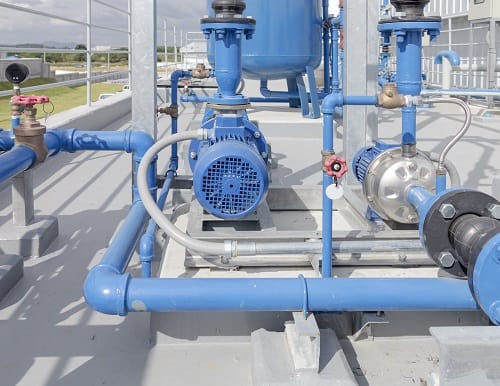Many engineers have one centrifugal pump and decide to run another with it in parallel to provide pump redundancy, enhance system flexibility or obtain higher system flows. If a project so large that available pumps aren’t large enough, more than one pump is mathematically indicated.
However, some precautions are necessary. Here are a few guidelines for parallel operation.
What Is Parallel Operation?
Parallel operation means that two pumps are transporting fluid from the same inlet into a common outlet, with each pump having the same differential head. The sum of the flow from each pump is the total flow.

How to Predict Performance
The common way to predict system performance is to produce a combined curve for all of the pumps by adding all of the individual flows from all of the pump curves at a common head. They system operates where the system curve meets the combined curve.
However, curves must be matched together properly to prevent one curve from overpowering the other. For example, if one of the pumps has a higher head at zero flow, it will overpower the other pump or pumps at low system flows.
The Curves Must be Properly Matched
The pump curves have to be matched evenly enough that they can share the load in a relative state of equality during low flows. The match doesn’t have to be perfect, but they do have to have matching heads during periods of low flow. This keeps one pump from blocking or stalling the others.
The most important characteristic is that the zero flow head, also known as “shut valve head,” are matched for any pumps installed together in parallel. This means that unstable pump curves must be avoided, especially in situations where the point of instability is a possibility. Unstable pump curves in parallel pumps can cause surging.
Parallel operation is most efficient with steeper pump curves to help share the load at low flows. If the pump curves are flat at low flow, minor variations in head can cause wide variations in flow, making it difficult for the pumps to share the load.
Care must be taken to avoid minor variations in performance. A pump whose performance characteristics changes due to wear and tear may no longer be in sync with the other pumps. In addition, two pumps with different drivers, such as one steam-driven pump and one electric motor-driven pump, may display performance characteristics that present problems at low flow.
Will Parallel Pumps Enhance Your System?
The efficacy of parallel pumps is going to depend on what you are trying to accomplish with them. If you are trying to both increase and decrease system flow by using parallel operation to accommodate changes in demand, it is important to know the type of system and its limitations.
With a relatively flat system curve, which means differences in levels are mostly static and pipe friction is minimal, parallel operation will create variations in performance that could be very useful.
If your system is a lengthy pipeline or a closed loop circuit whose resistance comes mostly from friction, there won’t be a lot of performance variation. This can be positive or negative, depending upon your goal.
Is Parallel Operation Right for You?
It all comes back to what we said earlier: it depends upon what you are trying to do. We recommend parallel operation under the following circumstances:
If there are circumstances that prevent you from using a larger pump, such as lack of space or pump availability, or constraints on driver size or power concerns keep you from using a larger pump, your best choice is going to be using two or more pumps in parallel.
When your system curve is relatively flat and you need to vary the flow to compensate for varying demand, parallel pumps are a great solution. Another great use for parallel operation: a situation where you can minimise the disruption caused to your operation in the case of a power failure by running multiple combinations of parallel pumps in a steep system.
Call our Perth experts on 1300 922 973 for more information.
